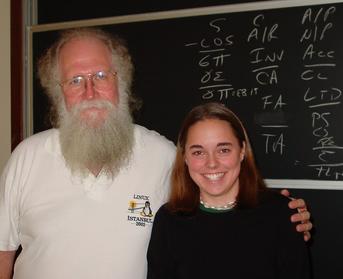

First off, I really did enjoy reading the article on replacing Microsoft Exchange with Linux [“Understanding and Replacing Microsoft Exchange” by Tom Adelstein, LJ, February 2003]. The article didn't explicitly state you were trying to replace Microsoft Exchange 5.5, but it was obvious to me that was the version you were working with. Microsoft's Exchange 5.5 was limited in the total size of the database, but that has changed in Exchange 2000 and Titanium. Exchange 2000's Exchange Storage Engine has been rewritten to allow much larger database sizes, which would be limited only to the total capacity of the hardware on which the database would reside. Also, I fail to understand the reasoning of why IMAP was provided as a connection mechanism. IMAP will provide you with a way to preview the e-mail message. Does your DLL plugin to Outlook provide a way for the message to remain on the e-mail server?
—Chris Lynch, Network Engineer
Tom Adelstein's reply: Thanks for your thoughtful letter. I appreciate your detailed understanding of Exchange. It is quite impressive. Our goal at Bynari was to create an RFC-compliant platform that allowed Microsoft Outlook to run in corporate workgroup mode. In the case of Outlook 2002, we wanted to provide calendar sharing and delegation.
I have been a happy LJ subscriber for many years now. I am usually not one to complain about things but the articles written by Marcel Gagné are getting irritating. His French Chef schtick is getting VERY old and detracts from his articles. Please consider having him stop that and simply write informative articles.
—David Vohwinkel
It is with much interest that I have read your editorial on clustering the previously unclustered [From the Editor by Don Marti, LJ, February 2003]. I seem to be unable to convince the powers that be at some CAD and CAD/CAM firms that this is an option. Therefore, I would very much like to get information on how to make programs that are not enabled for cluster technologies to work with cluster hardware configurations.
—Darald
If you have one huge, slow process, you'll probably need to rewrite the software using a clustering library. However, if you need to make many processes cooperate, OpenMosix automatically will migrate some of them to idle nodes in the cluster. See openmosix.sf.net.
—Editor
Thank you for excellent article on screen(1) [“Power Sessions with Screen” by Adam Lazur, LJ, January 2003]. Please persuade Adam Lazur to write a couple follow-up articles to this introductory one. I'm already starving for more.
—Jari
In the March 2003 issue, there was an article on weblogs that led readers to believe that Geeklog is a fork of PHP-Nuke [“Building with Blogs” by Doc Searls and Dave Sifry]. Much respect needs to be given to PHP-Nuke for helping to spur the weblog phenomenon, and I think the article presented that respect. However, Geeklog is not a fork of PHP-Nuke. Also, the article should have mentioned www.opensourcecms.com. It has the most popular packages in a demo-able state for users to test them without having to download, install and configure.
—Tony Bibbs
Seth Schoen's column “Broadcast Flag: MPAA's Latest Attack on Linux” (LJ, March 2003) appears to be mistitled. Mr. Schoen did not provide evidence on the MPAA making any form of attack on Linux or on any free operating system in the article. On a side note, he wrote, “Reporters were barred from meetings, which had a $100-per-meeting admission fee.” Were reporters specifically barred or was it just that reporters would have to pay $100 per meeting?
—Jason
Seth Schoen replies: Magazine editors have little space available for titles, so I could see where they would feel the need to condense “Broadcast Flag: MPAA's Latest Attack on the Right to Use Free Software to Lawfully Make and Interoperate with Recordings of Copyrighted Audiovisual Works” (which is what I would have called it) to “Broadcast Flag: MPAA's Latest Attack on Linux”. Reporters were specifically barred from meetings; they tried to participate, and they were kicked out.

I was pleased to see the LINUX license plate in your February 2003 issue [Letters], particularly as I have the same five letters on my car! I too was surprised to find that LINUX had not been chosen in my home state (Northern Territory, Australia). Having a LINUX license plate is certainly a talking point around town. I'd like all the owners of LINUX license plates from around the world to send a picture to LJ, along with a few words about their particular part of the world.
—Adrian Casey
A few years ago, when I first subscribed to LJ, someone made a mistake and sent two copies of each issue. One was sent to me, and the other was addressed to Eric W. Sattler, which was strange because there was nobody by that name that I'd ever heard of. I laughed at it, and that was that. In 2001, when our son was born, my wife and I were having trouble coming up with a name, and we remembered Eric from Linux Journal. It sounded better than anything we had thought of on our own, so Eric it was. He'll be two years old this June, and I wanted to send this mail to thank you for helping us name our son.
—Tom Sattler
In the March 2003 issue, the From the Editor column talks about community and the fear of spam people have when posting on Usenet or web forums. But there is something old that has become new. Cheap hardware and cable modems have caused a renaissance in the BBS scene, and one of the major factors in this is a GNU operating system named Linux. Why choose to eat spam when you can telnet into a friendly BBS?
—Anonymous
Although Bolivian users held an installfest at 11,000 feet, astronomers at Mauna Kea regularly install Linux at 14,000 feet. At that height we need extra cooling, usually by placing big fans (ten inches at least) near the monitor, which seems to produce the most heat. The lower efficiency of cooling is a big problem at these altitudes; yet, Linux runs well up there too.
—Peter Teuben
I find a T-shirt on the Linux Journal web site to be very offensive. The shirt has a typical Christian fish with the words “Linux Saves” inside. I'm surprised the person(s) involved with designing this T-shirt, its advertising and sale aren't offended.
—Norman Clerc
I remember you used to sprinkle little tech tips, command one-liners and other useful everyday kinds of knowledge throughout your magazine. What happened to those? I found them very helpful. I wrote a script called rpmff (RPM File Finder) to search RPMs looking for a specific file and find it useful.
—Doug Wright
Look for rpmff elsewhere in this issue.
—Editor
I bought two products that recently have been featured on the Linux Journal web site: a Hawking PN7127P print server [www.linuxjournal.com/article/6509] and a copy of Eric Meyer on CSS: Mastering the Language of Web Design [www.linuxjournal.com/article/6618]. Both are great. I appreciate having the articles, the reviews and even the ads. You folks have found the right balance.
—Mike Tarrant
I just read the article on weblogging by Doc Searls and Dave Sifry [LJ, March 2003]. Nice work. And, just to add another option for Linux, there is the Python Desktop Server (pyds.muensterland.org). It is similar in spirit to Radio Userland but runs on systems where Radio isn't available. In combination with the Python Community Server Software (pycs.net), you can get your own community server up with people participating quite fast.
—Georg
I recently built a little web application that quickly became production. So quickly in fact, it was only running on the PC running Linux that I used in development. It became the only Linux server in our otherwise all-Windows data center. That was last October. I never did see a new server, but the application just stayed up and worked. Then last Friday, it suddenly went dark. After being yelled at for how unreliable my “toy” was, I finally got one of our Windows Network “Engineers” to admit, “Well, we saw that box running in the data center, but because no one had touched it in months, we figured no one was using it.” I guess I'll call them to reboot it for me every now and then just so they know it's still in use.
—Michael K. Martin, DVM, MPH
I just want to let you know that I have been getting LJ for the past few years. It is a wonderful magazine, and I enjoy reading it every month. My son, who is ten years old, has started to read LJ, and he finds it enjoyable to read as well.
—Jim Wininger
I enjoyed the article about signals [“Linux Signals for the Application Programmer” by Dr B. Thangaraju, LJ, March 2003], but let me point a small omission. Listing 4 (page 48) needs to #include <errno.h> in order to compile.
—Paul

Here's a picture of me and Jon “maddog” Hall at the October 2002 Association of Computing Machinery (ACM) chapter meeting at Northeastern University in Boston. We especially appreciate his regular appearances at our meetings and his colorful and insightful commentary on the future of Linux worldwide. It's through our exposure to people like him that we can form open minds and think for ourselves instead of being led by one company's vision.
—Cathy Swenton, College of Computer Science, Northeastern University, Boston, Massachusetts
I work at a US Navy hospital in Naples, Italy. Recently, my Cisco 7507 inner security screening router died. Then the next week, my core switch. I had to piece together three Linux boxes quickly to use as routers to get through this problem. We are still running on two Linux routers, because my core switch hasn't recovered yet.
—Lee Randolph, CCNP
rsync [“rsync, Part I” by Mick Bauer, LJ, March 2003] is a wonderful tool, but if you want file synchronization, you may not even need to invoke it explicitly. The excellent file synchronization program Unison (www.cis.upenn.edu/~bcpierce/unison) also uses the rsync algorithm.
—Ben Crowell
After reading your comments about spam in the March 2003 issue [From the Editor], I wanted to make a comment of my own. We already have laws that would deal with the jerks who spam. The theft of bandwidth and nuisance could be dealt with through criminal charges, if the government would get off their backsides and enforce the laws we already have.
—Craig Sparks
I do not know the details behind the decision to downgrade David A. Bandel's Focus on Software column to the Upfront section of LJ, but I see it as a definite loss. Reading Mr. Bandel's column every month was one of the highlights of my subscription.
—Raymond Moczynski
BlogMax is a blog package that's based entirely upon Emacs. It works with both Emacs and XEmacs, is easily extensible and runs on several platforms (billstclair.com/blogmax/index.html). All that is required is a working install of Emacs or XEmacs and access to your web site files via FTP.
—Shane Simmons
I'd really like to suggest that LJ look into printing information on the Slackware distribution. I've been a Linux user and flag bearer since 1994 when I first installed Slackware; since then I've installed many different distributions of Linux and versions of UNIX. I always come back to Slackware due to its consistency, stability and well-thought-out development. I feel that Slackware has earned a bad reputation as being either dead or underdeveloped, neither of which could be further from the truth! I urge you to please consider an in-depth article on the status and beauty of Slackware.
—David Fleason